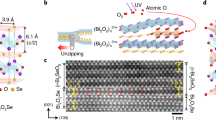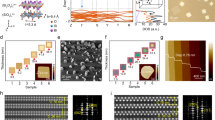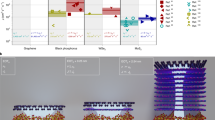Abstract
Two-dimensional semiconductors could be used to fabricate ultimately scaled field-effect transistors and more-than-Moore nanoelectronic devices. However, these targets cannot be reached without appropriate gate insulators that are scalable to the nanometre range. Typically used oxides such as SiO2, Al2O3 and HfO2 are, however, amorphous when scaled, and 2D hexagonal boron nitride exhibits excessive gate leakage currents. Here, we show that epitaxial calcium fluoride (CaF2), which can form a quasi van der Waals interface with 2D semiconductors, can serve as an ultrathin gate insulator for 2D devices. We fabricate scalable bilayer MoS2 field-effect transistors with a crystalline CaF2 insulator of ~2 nm thickness, which corresponds to an equivalent oxide thickness of less than 1 nm. Our devices exhibit low leakage currents and competitive device performance characteristics, including subthreshold swings down to 90 mV dec−1, on/off current ratios up to 107 and a small hysteresis.
This is a preview of subscription content, access via your institution
Access options
Access Nature and 54 other Nature Portfolio journals
Get Nature+, our best-value online-access subscription
$29.99 / 30 days
cancel any time
Subscribe to this journal
Receive 12 digital issues and online access to articles
$119.00 per year
only $9.92 per issue
Buy this article
- Purchase on Springer Link
- Instant access to full article PDF
Prices may be subject to local taxes which are calculated during checkout




Similar content being viewed by others
Data availability
The data that support the graphs within this Article and further details of this study are available from the corresponding author upon reasonable request.
References
Guerriero, E. et al. High-gain graphene transistors with a thin AlOx top-gate oxide. Sci. Rep. 7, 2419 (2017).
Tao, L. et al. Silicene field-effect transistors operating at room temperature. Nat. Nanotechnol. 10, 227–231 (2015).
Li, L. et al. Black phosphorus field-effect transistors. Nat. Nanotechnol. 9, 372–377 (2014).
Chen, X. et al. Large-velocity saturation in thin-film black phosphorus transistors. ACS Nano 12, 5003–5010 (2018).
Kang, J., Liu, W. & Banerjee, K. High-performance MoS2 transistors with low resistance molybdenum contacts. Appl. Phys. Lett. 104, 093106 (2014).
Chuang, S. et al. MoS2 p-type transistors and diodes enabled by high work function MoOx contacts. Nano Lett. 14, 1337–1342 (2014).
Ganapathi, K., Bhattacharjee, S., Mohan, S. & Bhat, N. High-performance HfO2 back gated multilayer MoS2 transistors. IEEE Electron Dev. Lett. 37, 797–800 (2016).
Illarionov, Y. et al. Improved hysteresis and reliability of MoS2 transistors with high-quality CVD growth and Al2O3 encapsulation. IEEE Electron Dev. Lett. 38, 1763–1766 (2017).
Smithe, K., Suryavanshi, S., Munoz-Rojo, M., Tedjarati, A. & Pop, E. Low variability in synthetic monolayer MoS2 devices. ACS Nano 11, 8456–8463 (2017).
Bolshakov, P. et al. Electrical characterization of top-gated molybdenum disulfide field-effect-transistors with high-k dielectrics. Microelectron. Eng. 178, 190–193 (2017).
Liao, W., Wei, W., Tong, Y., Chim, W. K. & Zhu, C. Electrical performance and low frequency noise in hexagonal boron nitride encapsulated MoSe2 dual-gated field effect transistors. Appl. Phys. Lett. 111, 082105 (2017).
Cho, Y. et al. Fully transparent p-MoTe2 2D transistors using ultrathin MoOx/Pt contact media for indium-tin-oxide source/drain. Adv. Funct. Mater. 28, 1801204 (2018).
Yang, L. et al. Chloride molecular doping technique on 2D materials: WS2 and MoS2. Nano Lett. 14, 6275–6280 (2014).
Liu, W. et al. Role of metal contacts in designing high-performance monolayer n-type WSe2 field effect transistors. Nano Lett. 13, 1983–1990 (2013).
Prakash, A. & Appenzeller, J. Bandgap extraction and device analysis of ionic liquid gated WSe2 Schottky barrier transistors. ACS Nano 11, 1626–1632 (2017).
Bolshakov, P. et al. Improvement in top-gate MoS2 transistor performance due to high quality backside Al2O3 layer. Appl. Phys. Lett. 111, 032110 (2017).
Wang, H. et al. Integrated circuits based on bilayer MoS2 transistors. Nano Lett. 12, 4674–4680 (2012).
Das, T. et al. Highly flexible hybrid CMOS inverter based on Si nanomembrane and molybdenum disulfide. Small 12, 5720–5727 (2016).
Wachter, S., Polyushkin, D., Bethge, O. & Mueller, T. A microprocessor based on a two-dimensional semiconductor. Nat. Commun. 8, 14948 (2017).
Xie, L. et al. Graphene-contacted ultrashort channel monolayer MoS2 transistors. Adv. Mater. 29, 1702522 (2017).
Hui, F. et al. On the use of two dimensional hexagonal boron nitride as dielectric. Microelectron. Eng. 163, 119–133 (2016).
Cassabois, G., Valvin, P. & Gil, B. Hexagonal boron nitride is an indirect bandgap semiconductor. Nat. Photon. 10, 262–266 (2016).
Geick, R., Perry, C. & Rupprecht, G. Normal modes in hexagonal boron nitride. Phys. Rev. 146, 543–547 (1966).
Hayes, W. Crystals with the Fluorite Structure (Clarendon Press, 1974).
Sugiyama, M. & Oshima, M. MBE growth of fluorides. Microelectron. J. 27, 361–382 (1996).
Illarionov, Y., Vexler, M., Fedorov, V., Suturin, S. & Sokolov, N. Electrical and optical characterization of Au/CaF2/p-Si(111) tunnel-injection diodes. J. Appl. Phys. 115, 223706 (2014).
Foster, A., Trevethan, T. & Shluger, A. Structure and diffusion of intrinsic defects, adsorbed hydrogen and water molecules at the surface of alkali-earth fluorides calculated using density functional theory. Phys. Rev. B 80, 115421 (2009).
Koma, A., Saiki, K. & Sato, Y. Heteroepitaxy of a two-dimensional material on a three-dimensional material. Appl. Surf. Sci. 41, 451–456 (1990).
Vishwanath, S. et al. Comprehensive structural and optical characterization of MBE grown MoSe2 on graphite, CaF2 and graphene. 2D Mater. 2, 024007 (2015).
Vishwanath, S. et al. MBE growth of few-layer 2H-MoTe2 on 3D substrates. J. Cryst. Growth 482, 61–69 (2018).
Banshchikov, A. et al. Epitaxial layers of nickel fluoride on Si(111): growth and stabilization of the orthorhombic phase. Phys. Solid State 57, 1647–1652 (2015).
Kaveev, A. et al. Epitaxial growth on silicon and characterization of MnF2 and ZnF2 layers with metastable orthorhombic structure. J. Appl. Phys. 98, 013519 (2005).
Ravez, J. The inorganic fluoride and oxyfluoride ferroelectrics. J. Phys. III 7, 1129–1144 (1997).
Si, M. et al. Steep-slope hysteresis-free negative capacitance MoS2 transistors. Nat. Nanotechnol. 13, 24–28 (2018).
Watanabe, M., Funayama, T., Teraji, T. & Sakamaki, N. CaF2/CdF2 double-barrier resonant tunneling diode with high room-temperature peak-to-valley ratio. Jpn J. Appl. Phys. 39, L716 (2000).
Suturin, S. et al. Optical detection of electron transfer through interfaces in CaF2: Eu–CdF2 SLs. Appl. Surf. Sci. 162, 474–478 (2000).
Smith, T. III, Phillips, J., Augustyniak, W. & Stiles, P. Fabrication of metal–epitaxial insulator–semiconductor field-effect transistors using molecular beam epitaxy of CaF2 on Si. Appl. Phys. Lett. 45, 907–909 (1984).
Tyaginov, S. et al. Modeling of deep-submicron silicon-based MISFETs with calcium fluoride dielectric. J. Comput. Electron. 13, 733–738 (2014).
Sokolov, N., Alvarez, J. & Yakovlev, N. Fluoride layers and superlattices grown by MBE on Si(111): dynamic RHEED and Sm2+ photoluminescence studies. Appl. Surf. Sci. 60, 421–425 (1992).
Dumcenco, D. et al. Large-area epitaxial monolayer MoS2. ACS Nano 9, 4611–4620 (2015).
Gurarslan, A. et al. Surface-energy-assisted perfect transfer of centimeter-scale monolayer and few-layer MoS2 films onto arbitrary substrates. ACS Nano 8, 11522–11528 (2014).
Jiang, N. On the oxidation of CaF2 in transmission electron microscope. Micron 43, 746–754 (2012).
Knobloch, T. et al. Impact of gate dielectrics on the threshold voltage in MoS2 transistors. ECS Trans. 80, 203–217 (2017).
Knobloch, T. et al. A physical model for the hysteresis in MoS2 transistors. IEEE J. Electron Dev. Soc. 6, 972–978 (2018).
Appenzeller, J., Zhang, F., Das, S. & Knoch, J. in 2D Materials for Nanoelectronics (eds Houssa, M. et al.) 207–234 (CRC Press, 2016).
Wang, J. et al. High mobility MoS2 transistor with low Schottky barrier contact by using atomic thick h-BN as a tunneling layer. Adv. Mater. 28, 8302–8308 (2016).
Xia, P. et al. Impact and origin of interface states in MOS capacitor with monolayer MoS2 and HfO2 high-k dielectric. Sci. Rep. 7, 40669 (2017).
Li, T., Wan, B., Du, G., Zhang, B. & Zeng, Z. Electrical performance of multilayer MoS2 transistors on high-κ Al2O3 coated Si substrates. AIP Adv. 5, 057102 (2015).
Illarionov, Y. et al. The role of charge trapping in MoS2/SiO2 and MoS2/hBN field-effect transistors. 2D Mater. 3, 035004 (2016).
Wen, M., Xu, J., Liu, L., Lai, P.-T. & Tang, W.-M. Effects of annealing on electrical performance of multilayer MoS2 transistors with atomic layer deposited HfO2 gate dielectric. Appl. Phys. Express 9, 095202 (2016).
Addou, R., Colombo, L. & Wallace, R. Surface defects on natural MoS2. ACS Appl. Mater. Interfaces 7, 11921–11929 (2015).
Leong, W. et al. Tuning the threshold voltage of MoS2 field-effect transistors via surface treatment. Nanoscale 7, 10823–10831 (2015).
Yu, Z., Zhang, Y.-W. & Yakobson, B. An anomalous formation pathway for dislocation-sulfur vacancy complexes in polycrystalline monolayer MoS2. Nano Lett. 15, 6855–6861 (2015).
Di Bartolomeo, A. et al. Hysteresis in the transfer characteristics of MoS2 transistors. 2D Mater. 5, 015014 (2017).
Kaushik, N. et al. Reversible hysteresis inversion in MoS2 field effect transistors. npj 2D Mater. Appl. 1, 34 (2017).
Illarionov, Y. et al. Energetic mapping of oxide traps in MoS2 field-effect transistors. 2D Mater. 4, 025108 (2017).
Ishizaka, A. & Shiraki, Y. Low temperature surface cleaning of silicon and its application to silicon MBE. J. Electrochem. Soc. 133, 666–671 (1986).
Binder, T. et al. MINIMOS-NT User’s Guide (Institut für Mikroelektronik, 1998).
Das, S., Chen, H., Penumatcha, A. & Appenzeller, J. High performance multilayer MoS2 transistors with scandium contacts. Nano Lett. 13, 100–105 (2012).
Allain, A., Kang, J., Banerjee, K. & Kis, A. Electrical contacts to two-dimensional semiconductors. Nat. Mater. 14, 1195–1205 (2015).
Acknowledgements
The authors acknowledge financial support through the Austrian Science Fund FWF grant no. I2606-N30. T.M., D.K.P. and S.W. acknowledge financial support by the Austrian Science Fund FWF (START Y 539-N16) and the European Union (grant agreement no. 785219 Graphene Flagship). This work was partly supported by the Russian Foundation for Basic Research (grant no. 18-57-80006 BRICS_t). We also gratefully acknowledge useful discussions with M. Jech and technical assistance from B. Stampfer. M.P. acknowledges financial support from the doctoral college programme TU-D funded by TU Wien. Y.Y.I. is a member of the Mediterranean Institute of Fundamental Physics (MIFP).
Author information
Authors and Affiliations
Contributions
Y.Y.I. introduced the idea of MoS2 FETs with an ultrathin CaF2 insulator, performed their characterization and prepared the manuscript. A.G.B. performed MBE growth of CaF2 and provided the substrates. D.K.P. and S.W. fabricated MoS2 FETs. T.K. performed TCAD simulations. M.T. contributed to preparation of figures. L.M. and M.P. performed SHG and Raman measurements, respectively. M.S.-P. and A.S.-T. performed TEM measurements and sample preparation, respectively. M.I.V. performed quantitative analysis of gate leakage currents using tunnel models. M.W. programmed electrical measurements. N.S.S., T.M. and T.G. supervised this work. All authors regularly discussed the results and commented on the manuscript.
Corresponding authors
Ethics declarations
Competing interests
The authors declare no competing interests.
Additional information
Publisher’s note: Springer Nature remains neutral with regard to jurisdictional claims in published maps and institutional affiliations.
Supplementary information
Supplementary Information
Supplementary sections 1–8 and Supplementary Figs. 1–14.
Rights and permissions
About this article
Cite this article
Illarionov, Y.Y., Banshchikov, A.G., Polyushkin, D.K. et al. Ultrathin calcium fluoride insulators for two-dimensional field-effect transistors. Nat Electron 2, 230–235 (2019). https://doi.org/10.1038/s41928-019-0256-8
Received:
Accepted:
Published:
Issue Date:
DOI: https://doi.org/10.1038/s41928-019-0256-8
This article is cited by
-
Two-dimensional perovskite oxide as a photoactive high-κ gate dielectric
Nature Electronics (2024)
-
Variability and high temperature reliability of graphene field-effect transistors with thin epitaxial CaF2 insulators
npj 2D Materials and Applications (2024)
-
The Roadmap of 2D Materials and Devices Toward Chips
Nano-Micro Letters (2024)
-
Exploring the high dielectric performance of Bi2SeO5: from bulk to bilayer and monolayer
Science China Materials (2024)
-
Two-dimensional semiconductor integrated circuits operating at gigahertz frequencies
Nature Electronics (2023)



